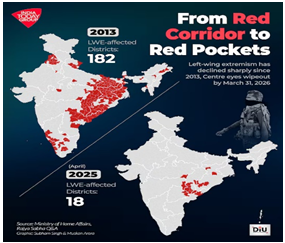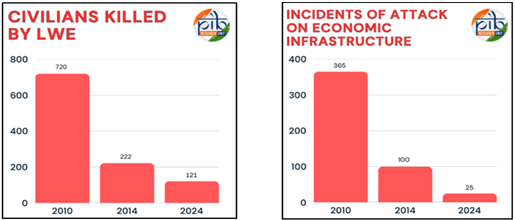

12th September 2025 (11 Topics)
Context:
Ten Maoists, including central committee member Manoj, were killed in an anti-Maoist operation in Gariaband, Chhattisgarh, marking a significant blow to the banned CPI (Maoist).
India’s Strategy and Success Against Left Wing Extremism
Background: Left Wing Extremism in India
- Origins and Ideology:
- Emerged from the Naxalbari Movement (1967, West Bengal).
- Rooted in socio-economic inequalities and Maoist ideology; targets marginalized tribal and rural populations.
- Methods: Armed rebellion, extortion, destruction of infrastructure, recruitment of civilians and children.
- Affected Regions – Red Corridor:
- States: Chhattisgarh, Jharkhand, Odisha, Maharashtra, Kerala, West Bengal, Madhya Pradesh, Andhra Pradesh, Telangana.
- Historical impact: Hindrance to education, healthcare, banking, postal services, and overall development.

Trends in LWE Violence
- Reduction in Affected Districts:
- From 126 districts in 2018 ? 90 in 2021 ? 38 in 2024.
- Most affected districts reduced from 12 ? 6 (Chhattisgarh: Bijapur, Kanker, Narayanpur, Sukma; Jharkhand: West Singhbhum; Maharashtra: Gadchiroli).
- Districts of Concern: Reduced from 9 ? 6.
- Other affected districts: Reduced from 17 ? 6.
- Decline in Violence:
- Incidents:1936 in 2010 ? 374 in 2024 (81% reduction).
- Deaths:1005 in 2010 ? 150 in 2024 (85% reduction).
- State-wise trend (2022–2024):
- Chhattisgarh: Highest casualties (267 in 2024)
- Other states: Significant decline, with zero deaths in Kerala and West Bengal in 2024
Government Strategy: National Policy and Action Plan (2015)
Core Principles:
- Zero tolerance for violence: Establish law and order in LWE regions.
- Inclusive development: Rapidly bridge developmental deficits caused by decades of Maoist insurgency.
Multi-pronged Approach:
- Security Measures:
- Deployment of CAPFs, India Reserve (IR) battalions, Joint Task Forces, CRPF battalions.
- Construction of 612 Fortified Police Stations (FPS) and 302 new security camps.
- Helicopters, night landing helipads, modernised intelligence infrastructure.
- Offensive operations with NIA and Enforcement Directorate to choke finances.
- Development Measures:
- Road connectivity:17,589 km sanctioned under RRP-I and RCPLWE schemes.
- Telecom: 7,768 towers commissioned; full mobile connectivity by Dec 2025.
- Financial inclusion: 1,007 bank branches, 937 ATMs, 5,731 post offices in LWE districts.
- Skill development & education: 48 ITIs, 61 SDCs, 178 EMRSs.
- Community Engagement:
- Civic Action Programmes (CAP), media awareness campaigns, tribal youth programs.
- Emphasis on participatory governance and empowerment of locals.
- Special Financial Assistance:
- SCA (Special Central Assistance): 30 crore for most affected districts; Rs. 10 crore for districts of concern.
- SIS (Special Infrastructure Scheme): 1,741 crore sanctioned for intelligence and operational strengthening.
- SRE Scheme: 3,260 crore released for security-related expenditure.
Success Stories and Achievements
- Operational Success:
- Neutralisation of key Naxal leaders: 15 top leaders in recent years.
- 2024–2025 operations: Hundreds of Naxalites killed, arrested, or surrendered (e.g., 50 surrendered in Bijapur, 237 killed in Chhattisgarh since Jan 2024).
- Substantial reduction in Naxal-affected police stations: 330 ? 104.
- Reduction in affected areas: 18,000 km² ? 4,200 km².
- Developmental Gains:
- Effective implementation of welfare schemes reaching marginalized communities.
- “DhartiAabaJanjatiya Gram Utkarsh Abhiyan” launched in 2024: Over 15,000 villages benefiting ~1.5 crore people.
- Significant increase in budget allocation for LWE-affected areas (300% increase).
- Statistical Highlights:
- 85% of LWE cadre strength in Chhattisgarh eliminated.
- Reduction of violent incidents by 53% (2014–2024).
- Casualties among security forces decreased by 73% (1,851 ? 509).

Challenges Remaining:
- Residual insurgent presence in core districts (Bijapur, Sukma, Gadchiroli).
- Sustaining development momentum and infrastructure maintenance.
- Preventing recruitment of new cadres due to socio-economic disparities.
Way Forward:
- Complete saturation of connectivity (road, mobile, financial) by 2026.
- Continued focus on skill development and tribal education for long-term integration.
- Enhanced coordination between central and state security agencies for residual LWE hotspots.
- Monitoring and evaluation of welfare schemes to ensure last-mile delivery.
- Strengthening legal and financial measures to prevent resurgence and financing of Naxalism.
More Articles


